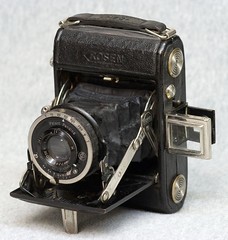Semi Rosen
The Semi Rosen (セミ・ローゼン) is a series of Japanese 4.5×6 folders. At least three different cameras share the same name. They were distributed by Ōsawa Shōkai, which was probably the owner of the Rosen name. The manufacturer of the different cameras is not known for sure, and is perhaps not the same for the three models (see the discussion below).
See also the postwar Rosen, a completely different 4.5×6 folder surely based on the Tsubasa Semi.
Contents
The original model
Description
The original Semi Rosen, dated early 1937, is certainly a name variant of the Semi Dymos. Its manufacturer is unknown:[1] at least one recent source says that the Semi Dymos was made by Mori,[2] but this is unconfirmed. (The company Proud-sha supplied the Baby Rosen and Rosen Four to Ōsawa Shōkai at the same period, but this does not imply that it was also the maker of the Semi Rosen.)
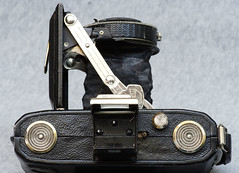 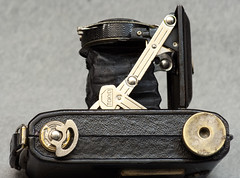
|
| Top and bottom views images by Jack Hufnagel (Image rights) |
The camera is an Ikonta 520 copy, with the typical three-part folding struts. There is a logo on the struts consisting of the word TOKYO inside an irregular hexagon vaguely reminding the silhouette of Mount Fuji. The brand name ROSEN is embossed in the front leather in capital letters.

|
| Viewfinder image by Jack Hufnagel (Image rights) |
There is a folding optical finder in the middle of the top plate. It is of the Newton type and its front part folds above the back one. It automatically opens when the folding bed is released — the finder latch is triggered by the release of the top folding strut. The finder cannot be latched shut whilst camera is unfolded. The folding bed release is to the right of the viewfinder — as seen by the photographer holding the camera horizontally. There is no body release.
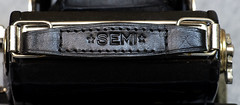
|
| Leather handle image by Jack Hufnagel (Image rights) |
The back is hinged to the left and the back latch is covered by a leather handle, embossed SEMI, with a five pointed star on either side. The film advance key is at the bottom right. A tripod socket is located on the bottom left, below the film supply chamber.
There is a special device for advance control, covered by a utility model (no.31617).[3] A cable release socket is located on the shutter housing rim. The red window is at the extreme left, protected by a vertically sliding cover; it is only used to set the position of the first exposure. The next exposures are controlled by a automatic roller driven frame counter contained under a square wooden fairing at the bottom left of the back. The frame number appears in a small round window. There is a small lever next to it, used to reset the counter. A triangular logo is faintly visible on the leather covering.[4] The device makes a clicking sound when the reaching the next number, and is therefore usable in low light. The whole device is exactly the same as the "talkie number" device of the Semi Dymos II, including the triangular logo.[5]
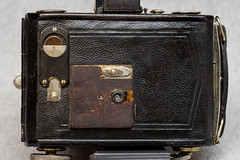
|
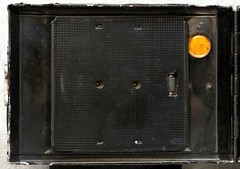
|
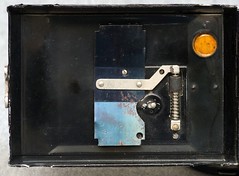
|
| Advance control device. The pressure plate was removed for the picture on the right, to show the underlying mechanism images by Jack Hufnagel (Image rights) | ||
The original Semi Rosen normally has a Rosen Anastigmat 75mm f/4.5 triplet[6] lens marked f/4.5, 6.3, 9, 12.5, 18, 25, and 36, on an everset Rosen shutter giving T, B, 5–250 speeds.
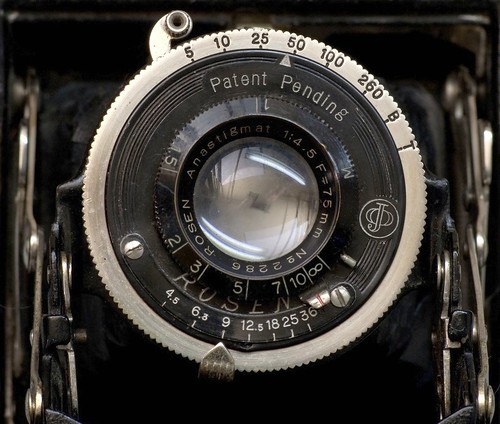
|
| Rosen shutter (5–250, B, T), Rosen Anastigmat 75mm f/4.5 lens no.2286. Notice the top speed mistakenly engraved as 260 instead of 250 image by Jack Hufnagel (Image rights) |
Advertisements
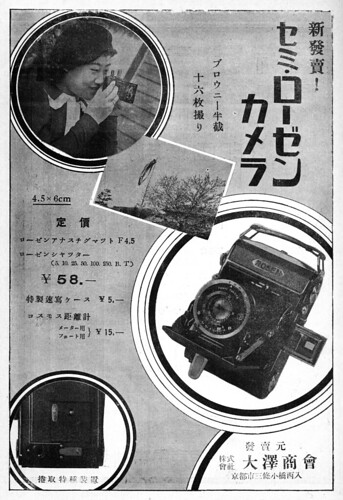
|
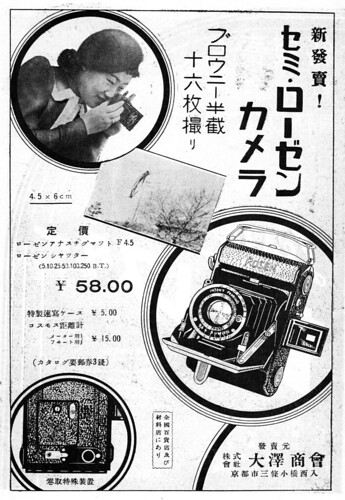
|
| April 1937 | May 1937 |
| Advertisements for the Semi Rosen in Asahi Camera (Image rights) | |
The Semi Rosen was only briefly advertised in the April and May 1937 issues of Asahi Camera,[7] reproduced above.[8] The advertisement dated April has actual pictures of the camera, whereas that dated May has rather poor drawings instead. In both documents, the camera is listed with the Rosen Anastigmat f/4.5 lens and Rosen shutter (T, B, 5–250) for ¥58 — case extra ¥5. An external rangefinder called Cosmos (コスモス) is offered as an accessory, though the camera itself has no accessory shoe. The Cosmos rangefinder was available in two versions graduated in metres or in feet, both priced at ¥15.
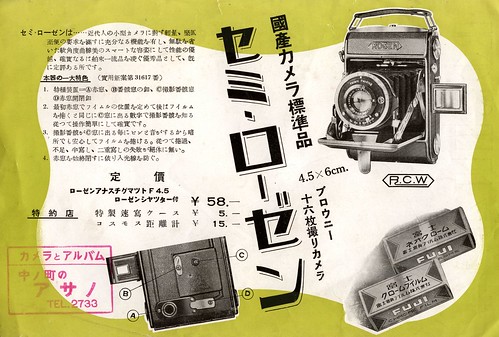
|
| Leaflet for the Semi Rosen, c.1937 (Image rights) |
The leaflet reproduced above gives the same features and prices for the Semi Rosen camera and Cosmos rangefinder. The pictures are the same as in the April 1937 advertisement, but the quality of the reproduction is somewhat better. The Rosen shutter looks exactly the same as the Light B mounted on the Semi Dymos; it is marked Patent Pending at the top and has a round MB logo on the right. There is an R.C.W logo printed on the leaflet, and the other face (with the Rosen Four) mentions "Rosen Camera Works" (ローゼン・カメラ・ウアークス). This is certainly not the name of an actual company, as many similar names ending in Camera Works.
Surviving examples

|
| Semi Rosen, original model, Rosen shutter (5–250, B, T), Rosen Anastigmat 75mm f/4.5 lens no.2286 image by Jack Hufnagel (Image rights) |
Two surviving examples of the original Semi Rosen have been observed so far. They are mostly similar to the camera pictured in the leaflet. In both cases, the Rosen shutter has an identical aspect and features, but bears a different logo, consisting the letter "J" superimposed over the letter "O". The camera pictured in this page has a lens serial number of 2286 and a black lens rim with white markings, whereas the other camera[9] has a focusing ring in a metal colour with black markings.
The Semi Rosen III

|
| Semi Rosen III, from Asahi Camera June 1940 (Image rights) |
The Semi Rosen III is a Baldax copy with a folding optical finder and a body release. (There is no record of a "Semi Rosen II".) The camera seems very similar to the vertical Semi Rody made by Shibayama, of which it was perhaps a rebadged version. The main body is essentially copied on the large Baldax model, but the folding optical finder is placed on the opposite side, so that the front door's hinge is at the right-hand side — as seen by a photographer holding the camera horizontally. The body release is to the right of the viewfinder; it perhaps retracts towards the main body when the front door is closed (a feature which is reported on the Adler C, certainly another rebadged variant of the Semi Rody). The film is advanced by a knob at the top left. The back is hinged to the right, and is locked by a latch on the left. The body edges are chrome plated,[10] and the name ROSEN is embossed in the leather covering at the front.

|
| Column in Asahi Camera June 1940, on the Semi Rosen III (Image rights) |
The camera was featured in the new products column of the April 1940 issue of Asahi Camera.[10] Three lens and shutter combinations were offered, all with a 75mm lens:
- Rosen f/4.5 lens, Lex shutter, ¥70;
- Keef f/4.5 lens, Prontor II shutter, ¥105;
- Welta[11] f/4.5 lens, Prontor II shutter, ¥125.
The pictured camera seems to have the lesser combination with the Lex shutter.
The Semi Rosen III also appears in the official list of set prices compiled in late 1940 and published in January 1941, where it is mentioned for ¥74 with no further detail.[12]
No surviving example of the camera has been observed yet.
The Semi Rosen U
Description
The Semi Rosen U is another Ikonta copy, perhaps introduced in 1940.[13] Its body completely differs from the original model: it is more angular, has metal trimming and seems to be made of die-cast metal instead of pressed steel. The folding optical finder is more modern, with its rear part folding above the front one. The camera normally has a body release on the left of the viewfinder and a folding bed release on the right. The back latch consists of a long sliding bar and there is no leather handle. The name ROSEN is embossed in the front leather: the letter "R" is larger than the others and extends under the whole word.
Documents
The Semi Rosen U appears for ¥88 in the January 1941 official price list.[14] A similar price list dated November 1941 has a "Semi Rosen U" and a "Semi Rosen UII", with no further details.[15]
Advertisements for the camera appear in Japanese photography magazines dated January to April 1942.[7] The January advertisement in Hōdō Shashin lists the camera with a Presto shutter (T, B, 1–500) and a choice of two lenses: a Rosen f/3.5 (¥161) and a Rosen f/4.5 (¥130).[16] The f/3.5 version probably corresponds to the Semi Rosen UII. The f/4.5 version appears alone in the February 1942 advertisement in Asahi Camera.[17]
The government inquiry compiled in April 1943 lists the same two versions of the Semi Rosen U, with a Rapid-Presto shutter made by Kinshō and a Hildar 75/4.5 or Hildar 75/3.5 three-element lens made by Ōki[18] — perhaps named after Hitler.
Actual examples
Two examples have been observed with the Rapid-Presto shutter.[19] The speed rim is engraved RAPID–PRESTO at the bottom, the shutter plate is inscribed PRESTO at the top and K.S. FABRIK at the bottom. These examples reportedly have a Hildar Anastigmat 75mm f/4.5 lens.
One example has been observed with a Rapit Anastigmat 75mm f/3.5 lens and an unknown shutter, only inscribed K.K.S. at the bottom of the shutter plate.[20] It reportedly has a K.S. Nippon marking on the back. (The same Rapit lens has been observed on a Tsubasa Kiko Three.)
Another example has been observed with a Prouder II shutter (T, B, 1–175, self-timer), obviously a copy of the Prontor II.[21] The shutter plate is inscribed PROUDER II at the bottom and reportedly Kostbar Bruder at the top. The lens is reported as a Coronar Anastigmat 75mm f/5.6. This example has no body release, and its folding bed release is placed at the bottom, next to the advance key.
Manufacturer
The manufacturer of the Semi Rosen U is not known for sure. A proposed attribution to Proud, maker of the Baby Rosen and Rosen Four, seems unlikely for that late model.[22] The "K.S. Nippon" marking reported on the back might indicate that the camera was made by Kinshō, maker of the Rapid-Presto shutter, which is known to have used a K.S. logo on the Vero Four.
Notes
- ↑ The original Semi Rosen is attributed to Ōsawa Shōkai in Kokusan kamera no rekishi, item 328, but this was only the distributor.
- ↑ Tanaka, p.132 of Nigan-refu no hanashi (zenpen).
- ↑ Leaflet Kokusan kamera hyōjun-hin Semi Rōzen, c.1937.
- ↑ Picture of the leaflet reproduced in this page, showing the camera's back.
- ↑ Picture of the Semi Dymos II in an advertisement in Asahi Camera May 1937 reproduced in Kokusan kamera no rekishi, p.78.
- ↑ The original documents do not mention the number of lens elements, but the camera with lens number 2286, pictured in this page, has a triplet.
- ↑ 7.0 7.1 Kokusan kamera no rekishi, p.343.
- ↑ Advertisements in Asahi Camera April 1937, p.A38, and May 1937, p.A35.
- ↑ Example observed in an online auction.
- ↑ 10.0 10.1 Column in Asahi Camera April 1940, pp.705–6.
- ↑ Name inferred from the katakana ウエルター.
- ↑ "Kokusan shashinki no kōtei kakaku", type 3, section 4A.
- ↑ Year 1937 mentioned in Sugiyama, items 1243–4, comes from a confusion with the original Semi Rosen.
- ↑ "Kokusan shashinki no kōtei kakaku", type 3, section 6A.
- ↑ "Kamera no kōtei kakaku kanpō happyō", November 1941, type 3, sections 6B and 7B.
- ↑ Advertisement reproduced in Kokusan kamera no rekishi, p.105.
- ↑ Advertisement visible in this page of Xylocopal's photolog.
- ↑ "Kokusan shashinki no genjōchōsa" ("Inquiry into Japanese cameras"), items 31–2, lens items Lb27 and Lc6, shutter item 18-R-4.
- ↑ Example pictured in Sugiyama, item 1244, and example pictured in McKeown, p.804.
- ↑ Example observed in an online auction.
- ↑ Example pictured in Sugiyama, item 1243.
- ↑ Sugiyama, items 1243–4, and McKeown, pp.572 and 804, attribute the Semi Rosen U both to "K.S. Fabrik" and to Proud.
Bibliography
- Anonymous company. Nihon saisho no 4×4 kamera Rōzen Foā / Kokusan kamera hyōjun-hin Semi Rōzen (日本最初の4×4カメラ ローゼンフォアー / 国産カメラ標準品 セミ・ローゼン, Rosen Four, first Japanese 4×4 camera / Semi Rosen, standard Japanese camera). Leaflet published c.1937 (date not indicated). Document reproduced in this Flickr set by Rebollo_fr.
- Asahi Camera. Advertisements by Ōsawa Shōkai:
- April 1937, p.A38;
- May 1937, p.A35.
- Asahi Camera. "Atarashii kikai to zairyō" (新しい機械と材料, New equipment and materials), April 1940, pp.705–7.
- Asahi Camera (アサヒカメラ) editorial staff. Shōwa 10–40nen kōkoku ni miru kokusan kamera no rekishi (昭和10–40年広告にみる国産カメラの歴史, Japanese camera history as seen in advertisements, 1935–1965). Tokyo: Asahi Shinbunsha, 1994. ISBN 4-02-330312-7. Items 328–30.
- "Kamera no kōtei kakaku kanpō happyō" (カメラの公定価格官報発表, Official announcement of the set prices of the cameras), November 1941. Extract of a table listing Japanese camera production and setting the retail prices, reproduced in "Bebī Semi Fāsuto 'Kore ha bebī wo nanotta semi-ki da'" (ベビーセミファースト"これはベビーを名乗ったセミ機だ", Baby Semi First, 'this is a Semi camera called Baby'), an article by Furukawa Yasuo (古川保男) in Camera Collectors' News no. 277 (July 2000). Nishinomiya: Camera Collectors News-sha. P. 27. Type 3, sections 6B and 7B.
- "Kokusan shashinki no genjōchōsa" (国産写真機ノ現状調査, Inquiry into Japanese cameras), listing Japanese camera production as of April 1943. Reproduced in Supuringu kamera de ikou: Zen 69 kishu no shōkai to tsukaikata (スプリングカメラでいこう: 全69機種の紹介と使い方, Let's try spring cameras: Presentation and use of 69 machines). Tokyo: Shashinkogyo Syuppan-sha, 2004. ISBN 4-87956-072-3. Pp.180–7. Items 31–2.
- "Kokusan shashinki no kōtei kakaku" (国産写真機の公定価格, Set prices of the Japanese cameras), listing Japanese camera production as of October 25, 1940 and setting the retail prices from December 10, 1940. Published in Asahi Camera January 1941 and reproduced in Shōwa 10—40nen kōkoku ni miru kokusan kamera no rekishi (昭和10〜40年広告にみる国産カメラの歴史, Japanese camera history as seen in advertisements, 1935—1965). Tokyo: Asahi Shinbunsha, 1994. ISBN 4-02-330312-7. Pp.108—9. Type 3, sections 4A and 6A.
- McKeown, James M. and Joan C. McKeown's Price Guide to Antique and Classic Cameras, 12th Edition, 2005-2006. USA, Centennial Photo Service, 2004. ISBN 0-931838-40-1 (hardcover). ISBN 0-931838-41-X (softcover). Pp.572 and 804.
- Sugiyama, Kōichi (杉山浩一); Naoi, Hiroaki (直井浩明); Bullock, John R. The Collector's Guide to Japanese Cameras. 国産カメラ図鑑 (Kokusan kamera zukan). Tokyo: Asahi Sonorama, 1985. ISBN 4-257-03187-5. Items 1243–4.
- Tanaka Masao (田中政雄). Nigan-refu no hanashi (zenpen) (二眼レフのはなし[前編], TLR stories [first part]). Gendai Kamera Shinsho (現代カメラ新書) no.68. Tokyo: Asahi Sonorama, 1980. No ISBN number. P.132. (Attributes the Semi Dymos to Mori.)
Links
In Japanese:
- Advertisement for the Semi Rosen U in Asahi Camera February 1942, visible in this page about old camera magazines of Xylocopal's photolog
